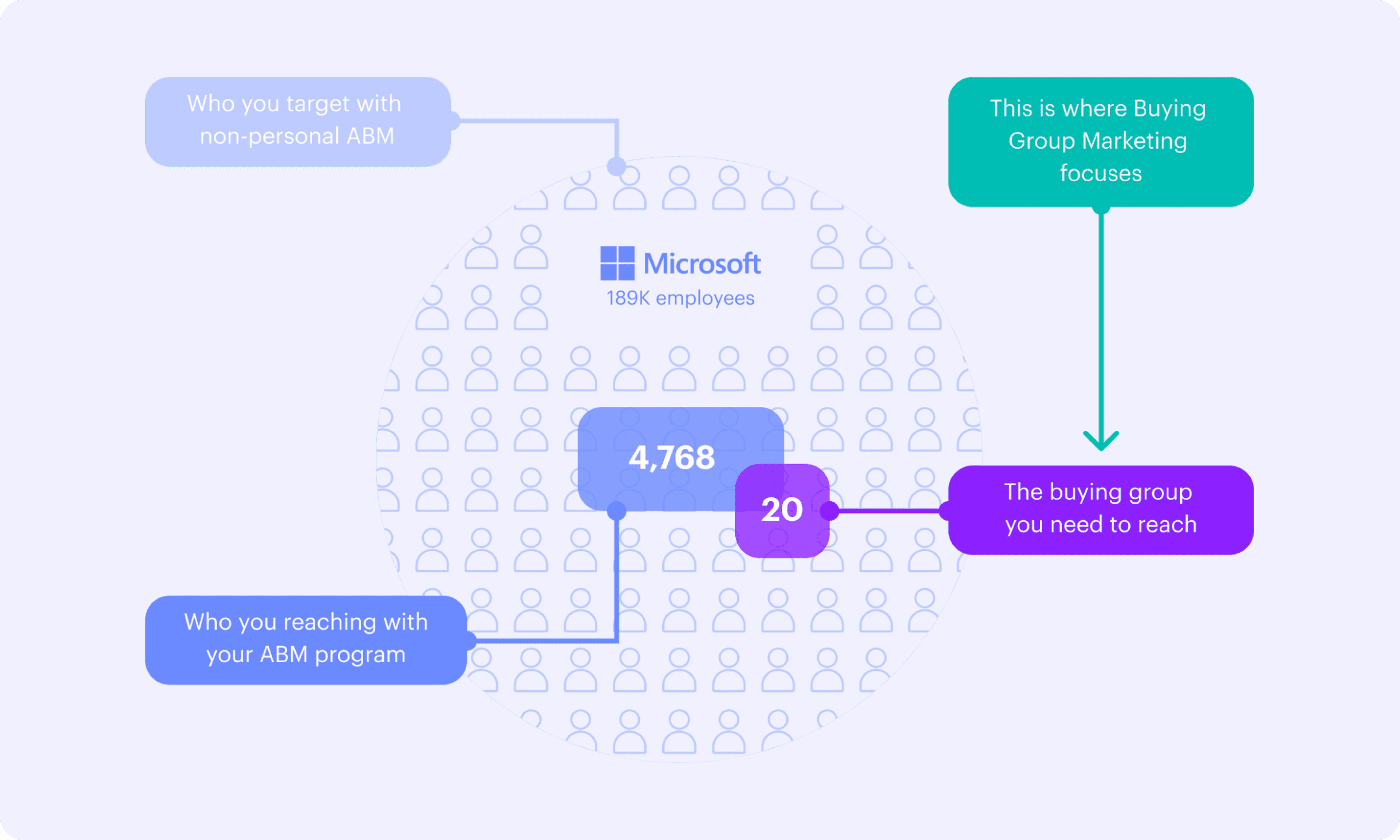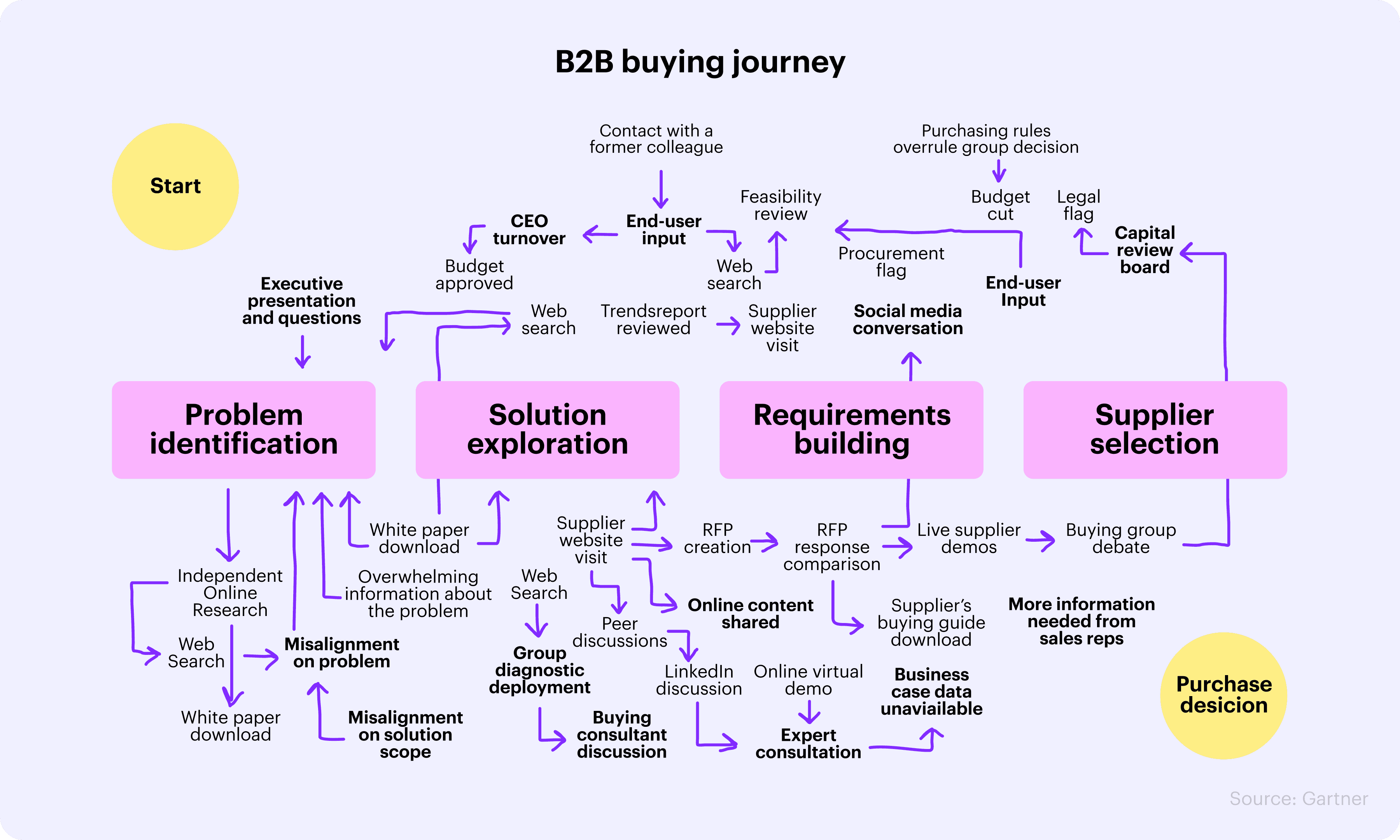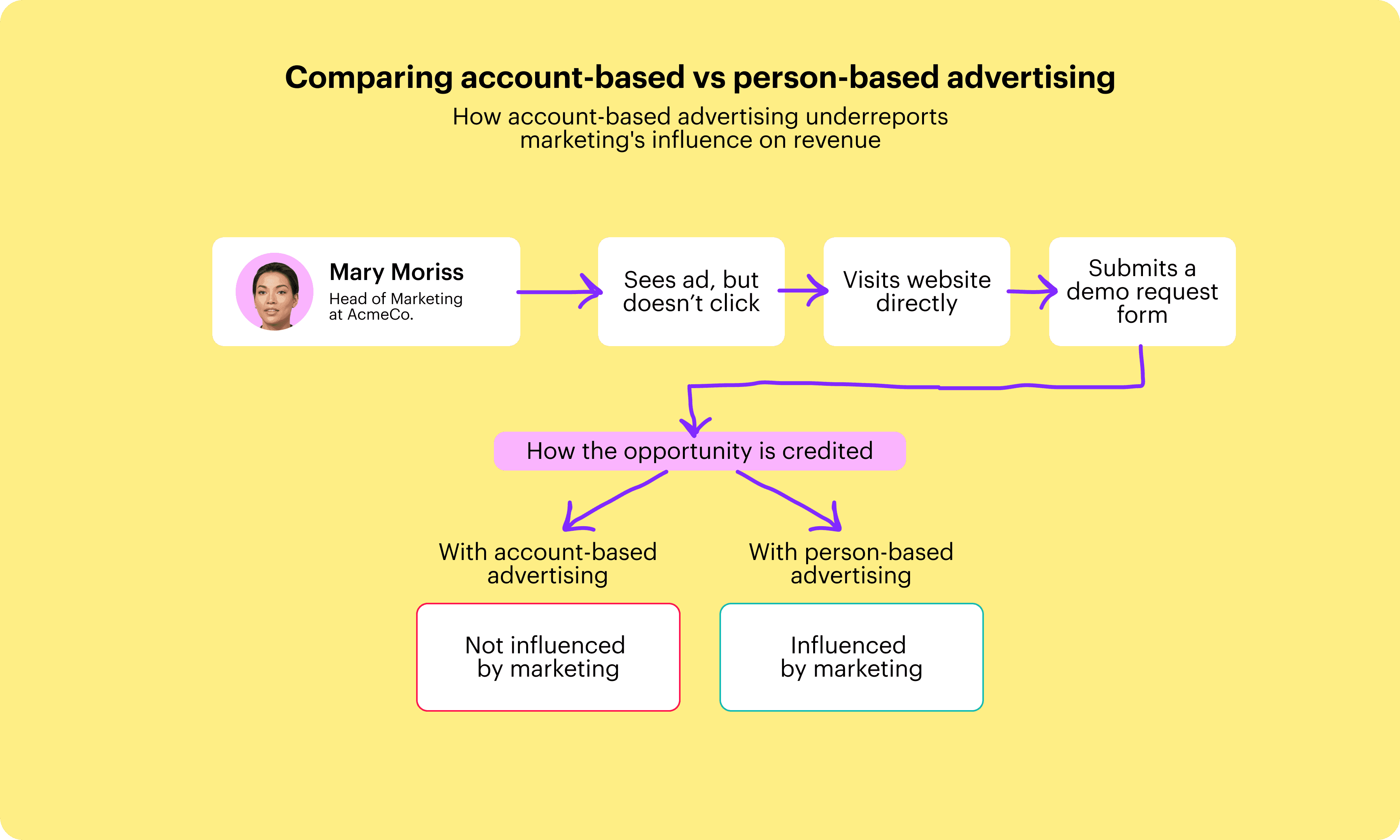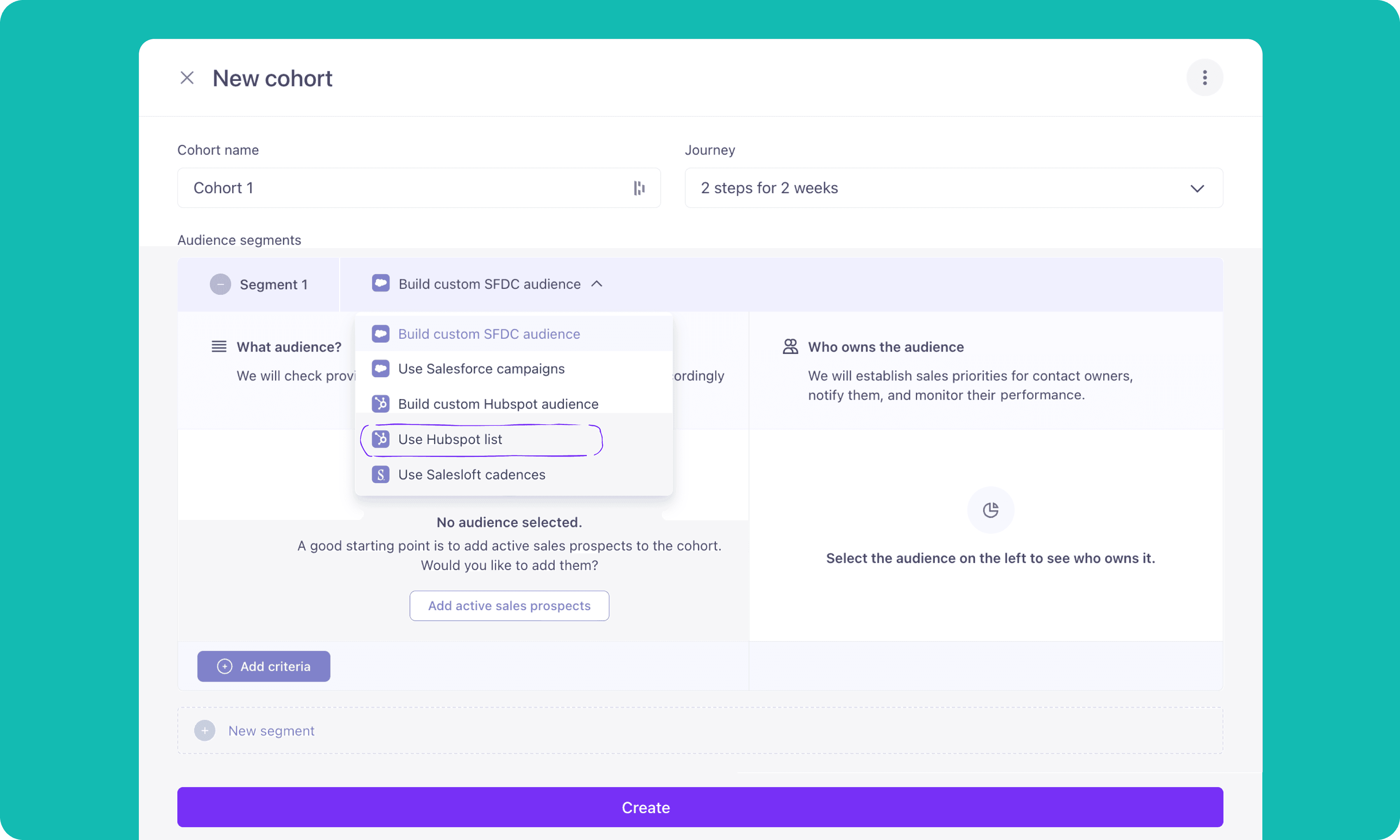Contact-Level vs Account-Based Advertising: How to Build Higher Converting Programs

Ever wonder why your account-based marketing program isn’t converting as well as you’d hoped?
It might be because you’re casting too wide a net, especially as you move upmarket.
The bigger your target accounts are, the more difficult it is to narrow your audience to the people you actually need to reach.
Broadly targeting accounts often leads to missed opportunities and wasted resources.
By engaging with the specific groups of people who actually make buying decisions at your target accounts, you can craft messages that truly resonate, drive higher conversions, and get a clearer picture of your program’s impact.
Contact-level advertising makes that possible.
Here’s why and how to add contact-level advertising to your marketing strategy.
The problem with account-based advertising
In theory, account-level targeting makes sense.
If you want to win Adobe as a customer, you create a marketing program focused on reaching and converting the “Adobe Account.”
You run ads to people who work at Adobe and hope the right person sees it.
The problem is that Adobe doesn’t make buying decisions, people at Adobe do.
As a result, account-based advertising programs tend to fall short in a few areas.
Account-based advertising is too broad
When you’re pursuing smaller companies of, say, 100 or fewer people, account-level targeting may work. It’s relatively easy for most ABM tools to reach the right people in a smaller company.
But what happens when you want to target companies with hundreds or thousands of employees?
The shotgun approach you took with smaller accounts often doesn’t translate as well due to the size and intricacies of larger organizations.
It’s like playing the most advanced game of Where is Waldo you’ve ever seen.
Here’s an example.
Say you want Microsoft as a customer. They have over 160,000 employees.
Your ABM program might help you filter out a lot of the clearly irrelevant people, but that still means you’re showing ads to thousands of people who aren’t viable prospects.

Who you really need to reach is the specific committee of prospects within your target account who are responsible for giving your product the green light (a buying group).
Account-based advertising isn’t built for the level of precision needed to efficiently reach these groups within larger organizations.
Account-based advertising focuses on companies, not people
Each person in a buying group has unique pain points and use cases for your product, and the messaging that resonates for one person may not resonate with another.
Also, the entire buying group doesn’t move through the buying process at the same pace.
Account-based advertising overlooks this critical aspect and treats everyone within the account the same.
When you lump everyone together, you end up showing each person the same ads regardless of where they are in the decision-making process or how they’ve previously engaged with your company.
The result is impersonal ads that don’t resonate with individual decision-makers.
You risk targeting prospects the sales team won’t pursue
As part of your webinar program, you create ads targeting people from one of your target accounts. Someone signs up, and they’re assigned to an SDR.
That’s a success, right?
Not necessarily.
Once that prospect is assigned to a salesperson, they decide they aren’t qualified and don’t pursue them.
It’s a problem plenty of sales and marketing teams face—a lack of audience alignment.
It’s not enough to align on the same accounts. Sales and Marketing also need to target the same people within the account.
Account-based advertising doesn’t account for that.
Account-based advertising makes it harder to tie your efforts to results
If you’ve ever been asked to justify a marketing budget, you know the importance of being able to tie your efforts to real business value (a.k.a generated pipeline and revenue).
Account-based advertising doesn’t give you granular enough data to tell the full story of marketing’s influence on revenue.
At best, you can see that an account you were targeting converted.
But how do you know if the sale converted solely because of the sales team’s effort or partially because of your marketing program?
You need to go deeper than account-level insights.
Why you should target people and buying groups instead of accounts
Contact-level ads help solve most of the downsides of account-based advertising.
Whether your ABM program has been less than stellar, or you think it’s working but can’t prove it with data, here’s how contact-level targeting can help.
Target the right people
Have you ever seen an ad from a SaaS company that feels completely impersonal and irrelevant?
It’s usually because you’ve been added to an ABM campaign that’s targeting your company, not you.
Without granular ad targeting, you risk doing the same thing with your program.
With contact-level targeting, you can narrow your audience to the people within an account that are a fit for your product.
This also addresses the issue of aligning with Sales.
When you and your sales team agree on the target audience, it’s easier to show ads to prospects who are a good fit and who salespeople will pursue.
Target one person across multiple channels
The Marketing Rule of Seven says that, on average, a person needs to see your brand’s message at least seven times before deciding to buy. Multiply that by all the buying group members you need to convert for B2B deals, and it becomes even more complex.
Getting your message in front of prospects on the channels they’re most likely to see will help you get that exposure faster.
With contact-level targeting, you can target one prospect across multiple channels. And if you use Influ2, we optimize your ads to show up on the platforms each prospect uses the most.
This comes in handy when you’re targeting larger buying groups because some people in the group might be active on Instagram, while others prefer LinkedIn or Facebook. If you’re targeting everyone primarily through just LinkedIn, a large chunk of the prospects you need to reach won’t see your ads.
Influ2 also allows you to target prospects across the web through Google’s Display Network and other channels.
Target prospects throughout the buying journey
When you target ads to specific people, you can cater your message to their needs throughout every stage of the buying journey.
To the point we made earlier, account-based advertising makes the assumption that everyone within an account moves through the buying journey at the same pace and that the journey is linear.
In reality, the process looks more like this, and each person in the buying process is at a different point on the map.

To be more effective, tailor your message to where each prospect is in the buyer journey.
For instance, instead of showing bottom-of-the-funnel content to everyone at a target account because one person scheduled a product demo, you can deliver ads based on where each individual is in the process and their level of buying intent.
Tie your programs to revenue
One of the most effective ways to prove your programs are directly influencing pipeline and revenue is detailed reporting.
Account-based advertising gives you incomplete data, so a lot of the influence your programs have on revenue goes unreported.
Let’s look at an example of where account-level targeting limits you and how contact-level advertising solves it to give you the full picture.
Say you’re going after Netflix.
You show ads to your “Netflix audience.” Someone sees your ad but doesn’t click it. Later on, they visit your website directly and fill out a demo request form.
With account-level advertising, that opportunity would be counted as an inbound lead because you couldn’t connect their ad impressions to their demo request.
However, with Influ2’s contact-level ads, you’d capture the impressions on a contact-level and know that the impression influenced the deal (we give you detailed reporting as well).

Unlike account-based ads, where you’re targeting the “Netflix audience,” with contact-level ads, you’re targeting Jane, Senior media buyer at Netflix, or Ben, Head of demand generation at Netflix.
Since the targeting is more granular, we can track impressions and clicks on a contact level and tie them back to influenced revenue.
Check out this guide to learn more about how to accurately measure the full influence of your marketing programs.
How to target people and buying groups
At this point, you may be thinking, “Contact-level ads sound great, but where do I start?”
Here’s a basic overview of the process.
1. Get the right tools
You won’t be able to do contact-level advertising from your native LinkedIn, Meta, or Google Ad accounts. While some platforms, like LinkedIn, allow you to upload a list of contacts, none of them report on individual clicks or impressions.
Without knowing exactly who saw and clicked your ads, you can’t measure the full impact of your program.
The most common example of this is when a prospect sees your ad but doesn’t click it.
Then two days later, they recall the ad, visit your site directly, and sign up for a trial.
With native ad platforms, your marketing program wouldn’t get credited with influencing that deal because they don’t report individual impressions and typically require a form-fill to match ad engagement to a person.
Another issue is that native ad platforms aren’t interconnected, and each uses different criteria for building audiences. LinkedIn’s ad targeting options are different from Meta’s, which are different from Google’s.
On top of that, their audience match rates are low.
All of this makes it impossible to target the same individual across each native ad platform.
And while some of the tools promote contact-level advertising, they:
- Don’t report who saw and clicked your ads
- Only allow you to target people on a few platforms
- Give you inaccurate data
- Provide incomplete data on revenue influence
With Influ2, you can target specific people, track who saw or clicked each ad (without form fills), and tie it all back to revenue.
2. Identify your target audience
This step is critical because as we mentioned earlier, Marketing and Sales need to align on the same audience to get the best results from your program.
Make sure you’re aligned on:
- The accounts you’re targeting
- The buying groups within each account
- The people in each buying group
Once you know who you want to reach, you can use Influ2 to import the target prospects directly from your CRM to start building your audience.

We also have some advanced options for building audiences. If you’re interested in learning more about how to use Influ2 for contact-level ABM, let's talk!
3. Build and launch your ads
Once you’ve built your audiences, you need to set up the buyer’s journey you want prospects to follow.
The buyer’s journey is essentially how you’ll outline the stages prospects will go through in their decision-making process and the steps involved for them to progress through each stage.
For instance, you might have a prospecting stage where you try to get targets to schedule a demo. Once they schedule a demo, you’ll move them into a pipeline closure stage, where the goal is to convert them into customers.
Once you outline the stages, you can create ads that correlate to each stage in the journey.
Remember when we said contact-level ads give you a level of granularity that you can’t get with account-level targeting? This is exactly what we mean.
Each individual prospect will progress through your buyer’s journey at their own pace, and Influ2 allows you to customize their ad experience based on their stage.
You can’t create programs with this level of complexity when you’re only targeting accounts.
Ready to start targeting people instead of accounts?
Marketing is becoming increasingly difficult. Broadstroke programs that treat everyone within a target account the same don’t move the needle the way they once did.
Buyers today want a personalized experience that shows you understand their unique needs.
According to a Forrester report conducted for Adobe, 57% of B2B customers expect personalized content when discovering a company’s products or services and 59% when researching or exploring them.
Contact-level ads are one of the most effective ways to deliver a one-to-one ad experience at scale.
If you’re ready to transition away from account-level ad targeting and start reaching decision-makers with contact-level ABM, schedule a demo to see how Influ2 can help!







